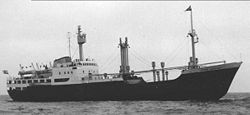MS Hans Hedtoft
 MS Hans Hedtoft | |
| Career (Denmark) | |
|---|---|
| Name: | Hans Hedtoft |
| Owner: | Royal Greenland Trading Company |
| Builder: | Frederikshavns Værft, Frederikshavn |
| Yard number: | 226 |
| Launched: | 13 August 1958 |
| Completed: | 17 December 1958 |
| Maiden voyage: | 7 January 1959 |
| Out of service: | 30 January 1959 |
| Homeport: | File:Flag of Denmark.svg Copenhagen |
| Identification: |
Code Letters OXKA 15px 15px 15px 15px |
| Fate: | Sank |
| General characteristics | |
| Tonnage: | 2,857 GRT |
| Capacity: | 95 passengers |
| Crew: | 40 crew |
| Armament: | 3 × 40mm anti-aircraft guns |
MS Hans Hedtoft was a Danish liner that struck an iceberg and sank on 30 January 1959 on her maiden voyage.[1]
History
Hans Hedtoft was built by Frederikshavns Værft at Frederikshavn. She was yard number 226, launched on 13 August 1958 and completed on 17 December.[2] She had a double bottom and seven watertight compartments and an armoured bow and stern. She was designed to provide a year-round service between Denmark and Greenland. Like the RMS Titanic, Hans Hedtoft had a riveted hull, a feature which was criticised by Knud Lauritzen, a shipowner. Lauritzen claimed that a riveted hull was not as resistant to ice pressure as a welded hull.[1] Hans Hedtoft had the Code Letters and radio callsign OXKA.[3]
Hans Hedtoft sailed from Copenhagen on her maiden voyage on 7 January 1959. Her voyage to Julianehaab, Greenland, was made in record time. Hans Hedtoft called at Nuuk, Sisimiut and Maniitsoq before returning to Julianehaab.[4]
On 29 January, she began her return journey.[5] The ship had 40 crew, 55 passengers and a cargo of frozen fish on board.[1] One of her passengers was the Danish parliament (Folketing) member Augo Lynge.[4] The next day, Hans Hedtoft collided with an iceberg about 35 miles (56 km) south of Cape Farewell.[5] A distress call was given at 13:56 (local time) stating that the ship had hit an iceberg at 59°30′N 43°00′W / 59.5°N 43°W[4]. The call was answered by the USCGC Campbell, the West German trawler Johannes Krüss[1] of Bremerhaven[4] and another West German trawler. Within an hour, another message was sent stating that the engine room was flooded.[1] At 15:12, it was announced that the ship was sinking. A final message was sent at 17:41 stating the ship was slowly sinking and requesting immediate assistance.[4] Aircraft in Newfoundland were grounded by the weather and unable to assist in the search for Hans Hedtoft.[1] The beginning of an SOS was received by Johannes Krüss at 17:41 after which communication with Hans Hedtoft was lost.[4] On 31 January, USCGC Campbell reported that conditions were the worst seen and there was no sign of Hans Hedtoft or her passengers and crew.[6] The search was called off on 7 February.[5] The only piece of wreckage ever recovered was a lifebelt which washed ashore some nine months after the ship sank.[4] As a result of the sinking, the airfield at Narsarsuaq, Greenland, which had closed in November 1958, was reopened.[7]
Like the RMS Titanic, Hans Hedtoft was said to be the safest ship afloat,[1] being described as "unsinkable" by some.[4]
Possible use as a warship
Hans Hedtoft was armed with three 40mm anti-aircraft guns, on the orders of the Ministry of Defence (MoD). The armament was not part of the original plans, and the ship was strengthened in three places to take the guns. An ammunition room was built into the bow of the ship. The MoD provided the anti-aircraft guns free of charge. Although fitted during tests, the guns were dismounted and carried aboard Hans Hedtoft at the time of her sinking. An order had been issued that the guns were to be removed from the ship immediately she arrived back in Copenhagen. It was claimed that the arming of Hans Hedtoft resulted in a warship being constructed without the approval of the Folketing.[4]
Memorial
On 30 January 2005, Queen Margrethe unveiled a monument at North Atlantic Wharf, Copenhagen, to the 95 people lost on Hans Hedtoft.[8]
References
- ↑ 1.0 1.1 1.2 1.3 1.4 1.5 1.6 "Little Titanic (1 of 2)". Time. 9 February 1959. http://www.time.com/time/magazine/article/0,9171,892163,00.html. Retrieved 12 December 2008.
- ↑ ""5613846"" (subscription required). Miramar Ship Index. R.B. Haworth. http://www.miramarshipindex.org.nz. Retrieved 4 November 2009.
- ↑ "Der Untergang der "Hans Hedtoft" / OXKA (I)" (in German). seefunknetz.de. http://www.seefunknetz.de/oxka.htm. Retrieved 12 December 2008.
- ↑ 4.0 4.1 4.2 4.3 4.4 4.5 4.6 4.7 4.8 "The ship - lost on its maiden voyage". qaqortoq.gl. http://www.qaqortoq.gl/jbl/english/hedtoftforlis.html. Retrieved 12 December 2008.
- ↑ 5.0 5.1 5.2 Eastlake, Keith (1998). Sea Disasters. London: Greenwich Editions. pp. p24. ISBN 0-86288-149-8.
- ↑ "Little Titanic (2 of 2)". Time. 9 February 1959. http://www.time.com/time/magazine/article/0,9171,892163-2,00.html. Retrieved 12 December 2008.
- ↑ "History.". iserit.greennet.gl. http://iserit.greennet.gl/bgbw/contact.htmll. Retrieved 12 December 2008.
- ↑ "Memorial to Hans Hedtoft victims". Copenhagen Post. http://www.cphpost.dk/print.jsp?o_id=85522. Retrieved 12 December 2008.
External links
- Overview and pictures (in Danish)
| |||||||||||
da:M/S Hans Hedtoft de:Hans Hedtoft (Schiff) no:M/S «Hans Hedtoft»
